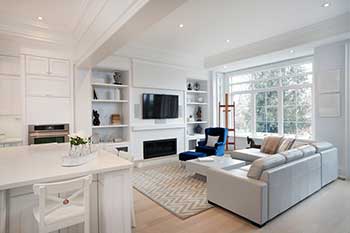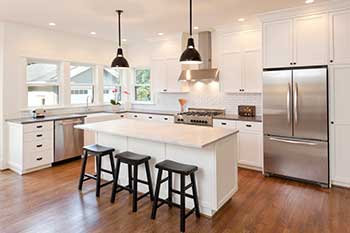

Monday-Friday: 8:00 AM - 5:00 PM
Saturday: By Appointment
Monday-Friday: 8:30 AM - 5:00 PM
Saturday: By Appointment

 Minimalism isn’t just a buzzword. It’s a thought process of simplification you can implement throughout your life, in an effort to reduce the amount of clutter and stress.
Minimalism isn’t just a buzzword. It’s a thought process of simplification you can implement throughout your life, in an effort to reduce the amount of clutter and stress.
From distinguishing between needs and wants, to removing duplicates among your things, to living with intention, minimalism is a movement of meaning that can cross into all areas of your life.
When it comes to your home and the space where you spend much of your time, implementing some minimalist ideas and practices can help you contain your mess and decrease your stress.
If decluttering and reducing stress are on your list of New Year’s resolutions for 2019, minimalism can help you do both. Here are five tips to help you incorporate minimalism into your home.
1. Fit furniture to each space: Furniture serves a purpose in every room, but it also takes up space. The best first step is to understand how the size of the room and the size of furniture can work together to create the best flow and function in each room. If your room feels tight on space or congested, or if you find it difficult to move about, take inventory of each piece of furniture and its purpose. Determine what pieces can be removed or eliminated and which ones need to remain. You might even find you need to replace existing pieces with something more appropriate in size. An overstuffed sofa might be fine in a spacious finished basement, but likely won’t work in a small study.
 2. Declutter surfaces: When items are left on coffee tables, desktops and dressers, a room quickly feels cluttered. Even necessary items left out can make a space feel messy. Sure the knife block is necessary, but does it need to be on the counter? Is there a way to organize your knives in a drawer, eliminating duplicates and keeping only the ones you use? Go through each room and attempt to remove anything that sits on top of furniture then find a new place for it. Pay particular attention to mail and paperwork; create a system for dealing with the paper before it gets put into piles.
2. Declutter surfaces: When items are left on coffee tables, desktops and dressers, a room quickly feels cluttered. Even necessary items left out can make a space feel messy. Sure the knife block is necessary, but does it need to be on the counter? Is there a way to organize your knives in a drawer, eliminating duplicates and keeping only the ones you use? Go through each room and attempt to remove anything that sits on top of furniture then find a new place for it. Pay particular attention to mail and paperwork; create a system for dealing with the paper before it gets put into piles.
3. Organize closets, cubbies and drawers: Minimalism can be great on the surface, but simply moving all your piles and stuff into hidden spaces in your home isn’t necessarily the answer. You might have a cleaner space, but the stress of opening a closet, or trying to locate an important document, will be overwhelming if all you’ve done is move things out of sight. Go through each drawer, especially the catchall drawers in the kitchen or home office, and be sure the contents are items you use, need or bring you joy. If the things you come across don’t fit these requirements, it might be time to get rid of them. Remember, as you clean out space and make more room, don’t keep something because you now have the space for it.
 4. Buy quality: As you assess the contents of your home, and need fewer items, it allows you to focus on making higher-quality purchases. Focusing on quality over quantity will help ensure you keep the minimalist approach and increase the likelihood that you’ll appreciate the items you do have.
4. Buy quality: As you assess the contents of your home, and need fewer items, it allows you to focus on making higher-quality purchases. Focusing on quality over quantity will help ensure you keep the minimalist approach and increase the likelihood that you’ll appreciate the items you do have.
5. Be thoughtful about what you let in: It can be tempting to fill an empty space once you clear it out. Keeping unnecessary items, duplicates and “stuff” from coming into your home in the first place is the most important step to keeping up with the clutter. Be intentional about the items you purchase and choose. Things you need, that serve a purpose and bring you joy are good guidelines to follow whenever you’re making a purchase.
Start 2019 off right! Clear the clutter and de-stress your life with a minimalist approach. If you take all of these steps and want to further simplify your living space, work with a contractor to make the necessary design changes in your home that will take your new minimalistic lifestyle to the next level.